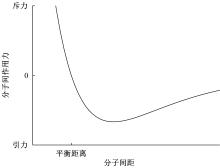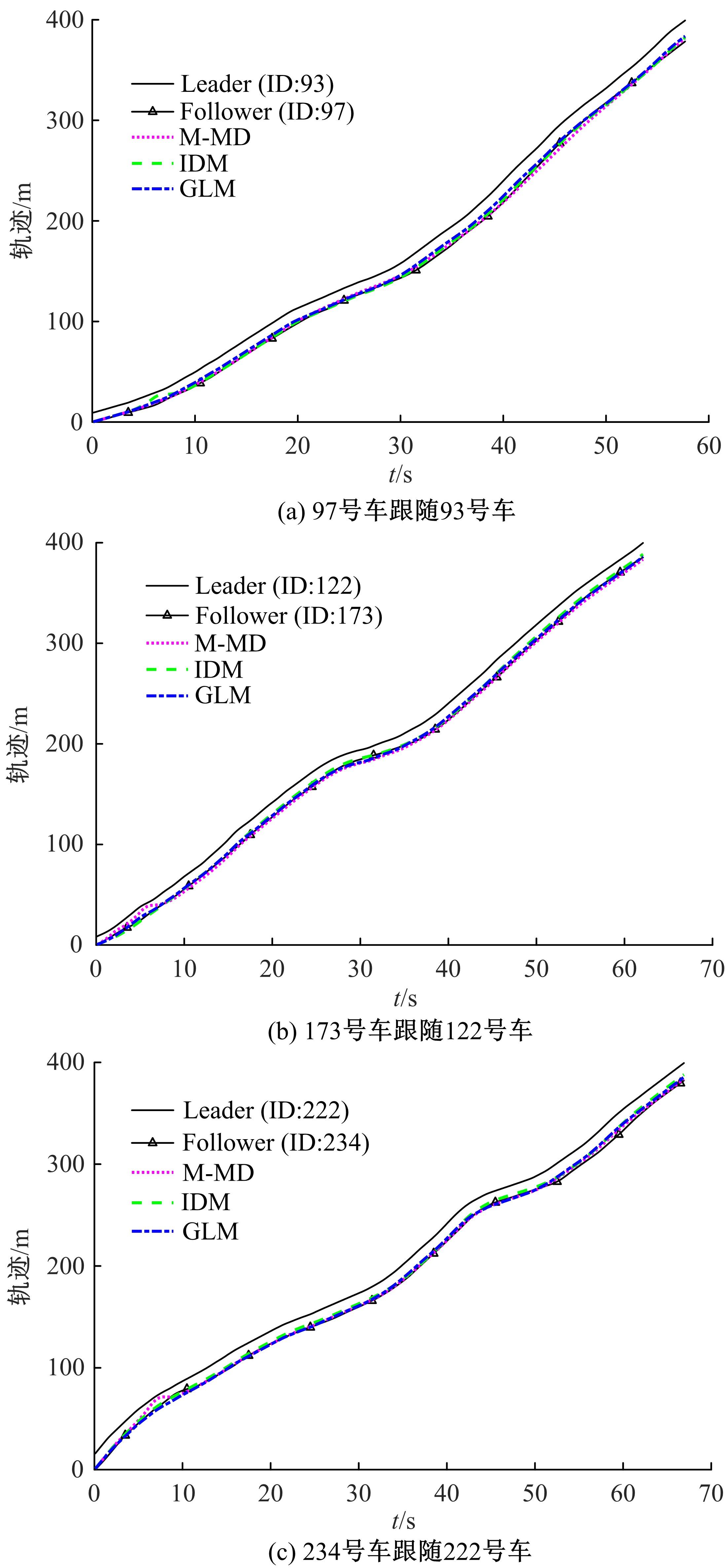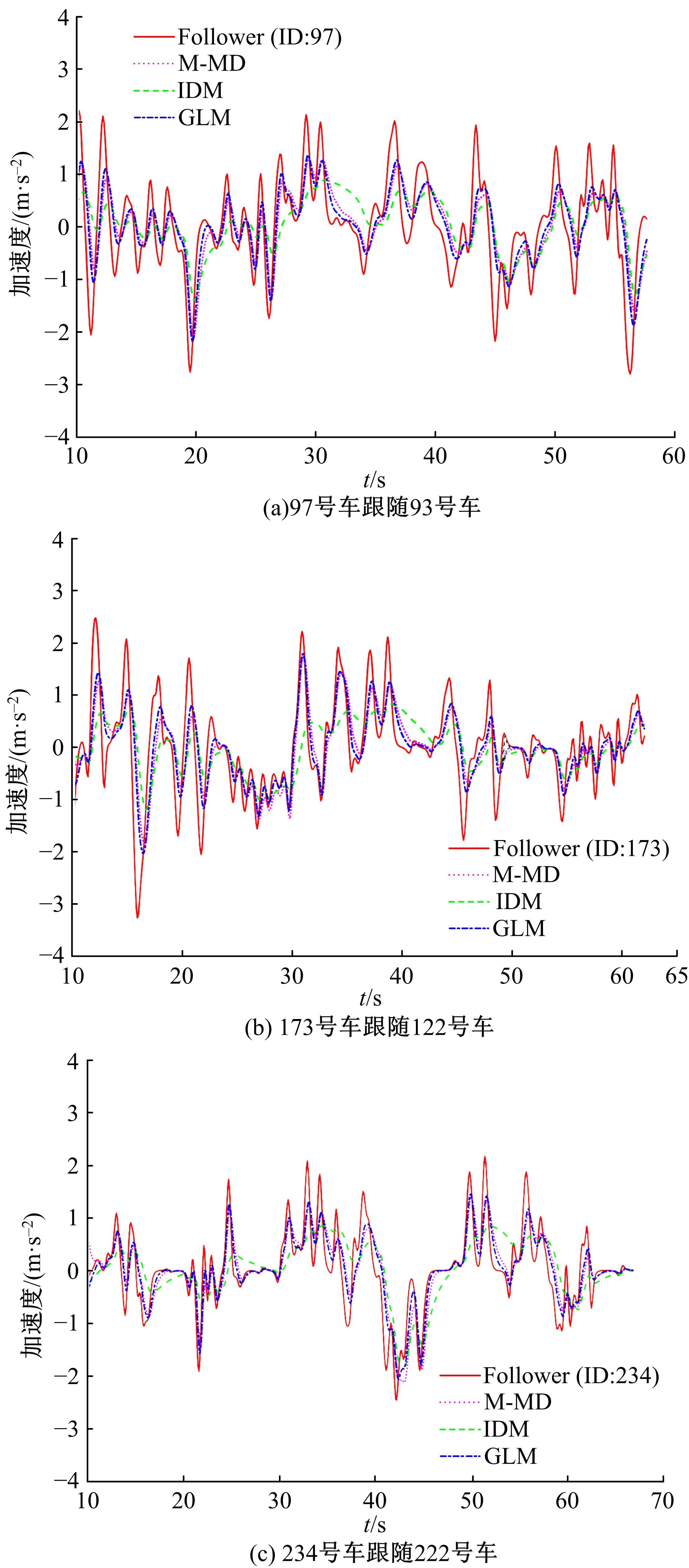Journal of Jilin University(Engineering and Technology Edition) ›› 2022, Vol. 52 ›› Issue (11): 2549-2557.doi: 10.13229/j.cnki.jdxbgxb20210395
Car⁃following dynamics characteristics and model based on Lennard⁃Jones potential
Da-yi QU1( ),Zi-xu ZHAO1,Yan-feng JIA1,Tao WANG1,Qiong-hui LIU2
),Zi-xu ZHAO1,Yan-feng JIA1,Tao WANG1,Qiong-hui LIU2
- 1.School of Mechanical and Automotive Engineering,Qingdao University of Technology,Qingdao 266520,China
2.Shandong Institute of Highway Technican,Jinan 250217,China
CLC Number:
- U491
| 1 | Gazis D C, Herman R, Rothery R W. Nonliner following-the-leader models of traffic flow[J]. Operations Research, 1961, 9(4): 545-567. |
| 2 | Bando M, Hasebe K, Nakayama A, et al. Dynamical model of traffic congestion and numerical simulation[J]. Physical Review E, 1995, 51(2): 1035-1042. |
| 3 | Helbing D, Tilch B. Generalized force model of traffic dynamics[J]. Physical Review E, 1998, 58(1): 133-138. |
| 4 | Jiang R, Wu Q S, Zhu Z J. Full velocity difference model for a car-following theory[J]. Physical Review E, 2001, 64(12): 017101. |
| 5 | 曲昭伟,潘昭天,陈永恒, 等. 基于最优速度模型的改进安全距离跟驰模型[J]. 吉林大学学报: 工学版, 2019, 49(4): 1092-1099. |
| Qu Zhao-wei, Pan Zhao-tian, Chen Yong-heng, et al. Car-following model with improving safety distance based on optimal velocity model[J]. Journal of Jilin University(Engineering and Technology Edition), 2019, 49(4): 1092-1099. | |
| 6 | 陈秀锋. 基于分子动力学的车辆运行安全特性研究[D]. 长春: 吉林大学交通学院, 2013. |
| Chen Xiu-feng. A study on vehicle operating safety characteristics based on molecular dynamics[D]. Changchun: College of Transportation, Jilin University, 2013. | |
| 7 | 曲大义,杨建,陈秀锋,等.车辆跟驰的分子动力学特性及其模型[J]. 吉林大学学报: 工学版, 2012, 42(5): 1198-1202. |
| Qu Da-yi, Yang Jian, Chen Xiu-feng, et al. Molecular kinetics behavior of car-following and its model[J]. Journal of Jilin University(Engineering and Technology Edition), 2012, 42(5) :1198-1202. | |
| 8 | 曲大义, 邴其春, 贾彦峰, 等. 基于分子动力学的车辆换道交互行为特性及其模型[J]. 交通运输系统工程与信息, 2019, 19(3): 68-74. |
| Qu Da-yi, Bing Qi-chun, Jia Yan-feng, et al. Molecular dynamics characteristics and models of vehicle lane changing interaction behavior[J]. Journal of Transportation Systems Engineering and Information Technology, 2019, 19(3) :68-74. | |
| 9 | Wolf M T, Burdick J W. Artificial potential functions for highway driving with collision avoidance[C]∥IEEE International Conference on Robotics and Automation, California, America, 2008: 3731-3736. |
| 10 | 李林恒, 甘婧, 曲栩, 等. 智能网联环境下基于安全势场理论的车辆跟驰模型[J]. 中国公路学报, 2019, 32(12): 76-87. |
| Li Lin-heng, Gan Jing, Qu Xu, et al. Car-following model based on safety potential field theory under connected and automated vehicle environment[J]. China Journal of Highway and Transport, 2019, 32(12): 76-87. | |
| 11 | 李娟,曲大义,刘聪,等.基于分子动力学的跟驰特性及其模型[J].公路交通科技, 2018, 35(3): 126-131. |
| Li Juan, Qu Da-yi, Liu Cong, et al. Car-following characteristics and its models based on molecular dynamics[J]. Journal of Highway and Transportation Research and Development, 2018, 35(3): 126-131. | |
| 12 | 杨龙海,王晖,李帅, 等. 改进分子动力学的车辆跟驰模型[J]. 重庆大学学报, 2021, 44(7): 26-33. |
| Yang Long-hai, Wang Hui, Li Shuai, et al. Improved molecular dynamics car-following model[J]. Journal of Chongqing University,2021,44(7): 26-33. | |
| 13 | 曹炳阳, 陈民, 过增元. 纳米通道滑移流动的分子动力学研究[J]. 工程热物理学报, 2003(4): 670-672. |
| Cao Bing-yang, Chen Min, Guo Zeng-yuan. Molecular dynamics studies of slip flow in nanochannel[J] Journal of Engineering Thermophysics, 2003(4): 670-672. | |
| 14 | Lennard-Jones J E. Cohesion[J]. Proceedings of the Physical Society, 1931, 43(5): 461-482. |
| 15 | Wang X, Ramírez-Hinestrosa S, Dobnikar J, et al. The Lennard-Jones potential: when (not) to use it[J]. Physical Chemistry Chemical Physics, 2020, 22(19): 10624-10633. |
| 16 | Ferguson D M, Kollman P A. Can the Lennard-Jones 6‐12 function replace the 10‐12 form in molecular mechanics calculations [J]. Journal of Computational Chemistry, 1991, 12(5): 620-626. |
| 17 | 王涛, 高自友, 赵小梅. 多速度差模型及稳定性分析[J]. 物理学报, 2006(2): 634-640. |
| Wang Tao, Gao Zi-you, Zhao Xiao-mei. Multiple velocity difference model and its stability analysis[J]. Acta Physica Sinica, 2006(2): 634-640. | |
| 18 | 王殿海, 陶鹏飞, 金盛, 等. 跟驰模型参数标定及验证方法[J]. 吉林大学学报: 工学版, 2011, 41(): 59-65. |
| Wang Dian-hai, Tao Peng-fei, Jin Sheng, et al. Method of calibrating and validating car-following model[J]. Journal of Jilin University(Engineering and Technology Edition), 2011, 41(Sup.1): 59-65. | |
| 19 | Montanino M, Punzo V. Making NGSIM data usable for studies on traffic flow theory: multistep method for vehicle trajectory reconstruction[J]. Transportation Research Record, 2013(1): 99-111. |
| 20 | 鲁斌. 基于数据驱动方法的车辆跟驰行为建模与分析[D]. 成都: 西南交通大学交通运输与物流学院, 2017. |
| Lu Bin. Modeling and analysis of car-following behavior using data-driven methods[D]. Chengdu: College of Transportation and Logistics, Southwest Jiaotong University, 2017. | |
| 21 | 罗亚中, 袁端才, 唐国金. 求解非线性方程组的混合遗传算法[J]. 计算力学学报, 2005(1): 109-114. |
| Luo Ya-zhong, Yuan Duan-cai, Tang Guo-jin. Hybrid genetic algorithm for solving systems of nonlinear equations[J]. Chinese Journal of Computational Mechanics, 2005(1): 109-114. |
| [1] | Xin ZHANG,Wei-hua ZHANG. Safety analysis of main line under different traffic conditions in expressway confluence area [J]. Journal of Jilin University(Engineering and Technology Edition), 2022, 52(6): 1308-1314. |
| [2] | Wen-hui ZHANG,Jing YI,Wei LIU,Qiu-ying YU,Lian-zhen WANG. Injury mechanism of occupants in bus during rear-end crash based on MADYMO [J]. Journal of Jilin University(Engineering and Technology Edition), 2022, 52(1): 118-126. |
| [3] | Da-yi QU,Kai-xian HEI,Hai-bing GUO,Yan-feng JIA,Tao WANG. Game behavior and model of lane-changing on the internet of vehicles environment [J]. Journal of Jilin University(Engineering and Technology Edition), 2022, 52(1): 101-109. |
| [4] | Zhi-wei LIU,Jian-rong LIU,Wei DENG. Travelers′ choice behavior of autonomous vehicles based on latent class [J]. Journal of Jilin University(Engineering and Technology Edition), 2021, 51(4): 1261-1268. |
| [5] | Jin XU,Cun-shu PAN,Jing-hou FU,Jun LIU,Dan-qi WANG. Speed behavior characteristic on typical driving scenarios and along switched scenarios [J]. Journal of Jilin University(Engineering and Technology Edition), 2021, 51(4): 1331-1341. |
| [6] | Wei-xiong ZHA,Qi-yan CAI,Jian LI,Li-xin YAN. Optimization of offset of urban arterial signal coordination under condition of vehicle entry and exit on side road [J]. Journal of Jilin University(Engineering and Technology Edition), 2021, 51(2): 565-574. |
| [7] | SONG Xian-min, DENG Xiao-lei, GAO Ming, QU Zhao-wei. Full velocity difference model based on dynamic reaction time [J]. 吉林大学学报(工学版), 2017, 47(6): 1703-1709. |
| [8] | SUN Yi-xuan,SHAO Chun-fu,YUE Hao,ZHU Liang. Urban traffic accident severity analysis based on sensitivity analysis of support vector machine [J]. 吉林大学学报(工学版), 2014, 44(5): 1315-1320. |
| [9] | WANG Dian-hai, TAO Peng-fei, JIN Sheng, MA Dong-fang. Method of calibrating and validating car-following model [J]. 吉林大学学报(工学版), 2011, 41(增刊1): 59-65. |
| [10] | DONG Hong-hui,SUN Xiao-liang,JIA Li-min,QIN Yong. Multimode traffic volume prediction model [J]. 吉林大学学报(工学版), 2011, 41(03): 645-649. |
| [11] | WANG Dian-hai,QI Hong-sheng. Road travel time under signal control [J]. 吉林大学学报(工学版), 2010, 40(03): 655-0660. |
| [12] | LIU Yan,GAO Qing,HUANG Yong,Yü Ming,ZHANG Zhong-jin. Seasonal running performance in hydronic ice-snow melting on road by using the earth energy [J]. 吉林大学学报(工学版), 2010, 40(01): 72-0076. |
| [13] | JIANG Gui-yan,WU Chao-teng. Link segmenting model of road network for the travel time collection based on GPS [J]. 吉林大学学报(工学版), 2009, 39(增刊2): 177-0181. |
| [14] | Jiang Guiyan, Zheng Zuduo, Bai Zhu, Dai Leilei, Zhao Jiaqi. Simulationbased assessment of variable message signs route guidance information under congestion condition [J]. 吉林大学学报(工学版), 2006, 36(02): 183-0187. |
| [15] | YANG Zhaosheng, YANG Qingfang, FENG Jinqiao. Combined time-space average speed information fusion algorithm and its application [J]. 吉林大学学报(工学版), 2004, (4): 675-678. |
|
||











